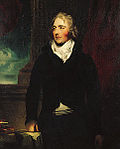Whig Tory Conservative Portrait NameHonorifics and constituency Term of office Party Ministry Thomas Townshend, 1st Viscount Sydney before 1789 Viscount Sydney after 1789 4 September 6 March Whig Pitt I William Grenville, 1st Baron Grenville 6 March 22 June Tory(Pittite) Henry Dundas, 1st Viscount Melville MP for Edinburgh 22 June 25 April Tory George Legge, 3rd Earl of Dartmouth 25 April 2 July Tory Addington Robert Stewart, Viscount Castlereagh MP for Down before 1805 Boroughbridge after 1806 2 July 11 February Tory Pitt II Gilbert Elliot-Murray-Kynynmound, 1st Earl of Minto 11 February 15 July Whig All the Talents ( Whig –Tory ) Thomas Grenville MP for Buckingham 15 July 30 September Whig George Tierney MP for Athlone 30 September 6 April Whig Robert Dundas, 2nd Viscount Melville MP for Midlothian 6 April 11 July Tory Portland II Dudley Ryder, 1st Earl of Harrowby 11 July November Tory Perceval Robert Dundas, 2nd Viscount Melville MP for Midlothian before 1811 Viscount Melville after 1811 November 4 April Tory Robert Hobart, 4th Earl of Buckinghamshire 4 April 4 June Tory Liverpool George Canning MP for Liverpool 4 June June Tory Charles Bathurst MP for Harwich June 4 February Charles Williams-Wynn (1775–1850) MP for Montgomeryshire 4 February 4 February Tory Canning ( Canningite – Whig ) Goderich ( Canningite – Whig ) Wellington– Peel Robert Dundas, 2nd Viscount Melville 4 February 17 September Tory Edward Law, 1st Earl of Ellenborough 17 September 1 December Tory Charles Grant, 1st Baron Glenelg MP for Inverness-shire 1 December 18 September Whig Grey Melbourne I Edward Law, 1st Earl of Ellenborough 18 September 23 April Conservative Peel I John Hobhouse, 1st Baron Broughton MP for Nottingham 23 April 30 August Whig Melbourne II Edward Law, 1st Earl of Ellenborough 4 September 23 October Conservative Peel II William Vesey-FitzGerald, 2nd Baron FitzGerald and Vesey 23 October 17 May Conservative F. J. Robinson, 1st Viscount Goderich 17 May 30 June Conservative John Hobhouse, 1st Baron Broughton MP for Nottingham before 1847 Harwich after 1848 8 July 5 February Whig Russell Fox Maule-Ramsay, 11th Earl of Dalhousie MP for Perth 5 February 21 February Whig John Charles Herries MP for Stamford 28 February 17 December Conservative Who? Who? Charles Wood, 1st Viscount Halifax MP for Halifax 30 December 3 March Whig Aberdeen ( Peelite – Whig ) Robert Vernon MP for Northampton 3 March 21 February Whig Palmerston I Edward Law, 1st Earl of Ellenborough 6 March 5 June Conservative Derby– Disraeli II Edward Stanley, 15th Earl of Derby MP for King's Lynn 5 June 2 August Conservative 























